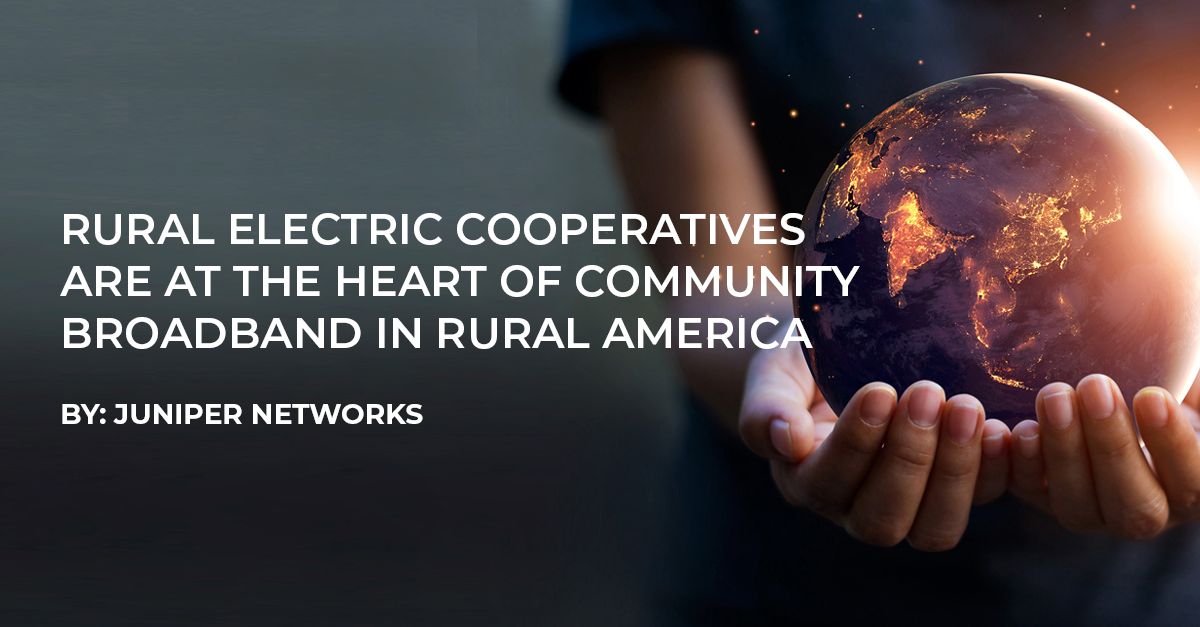 Cooperatives brought electricity and telephone services to rural households nearly a century ago. Today, rural electric cooperatives are ideally positioned to deliver affordable, high-speed broadband to their members. By leveraging federal funding, rural electric cooperatives are taking an increasingly active role in closing the digital divide and ultimately improving access to education, healthcare, and economic opportunities for the communities they serve. At the same time, cooperatives can modernize their operational networks to deliver reliable power at a lower cost.
Cooperatives brought electricity and telephone services to rural households nearly a century ago. Today, rural electric cooperatives are ideally positioned to deliver affordable, high-speed broadband to their members. By leveraging federal funding, rural electric cooperatives are taking an increasingly active role in closing the digital divide and ultimately improving access to education, healthcare, and economic opportunities for the communities they serve. At the same time, cooperatives can modernize their operational networks to deliver reliable power at a lower cost.
This article provides insights into a proven success model that addresses both critical challenges simultaneously, along with practical steps that rural electric cooperatives can take to get started.
The Broadband Opportunity
Thirty-five percent of rural Americans lack access to minimally acceptable broadband speeds, according to the White House. Dial-up and DSL just don’t cut it anymore.
Inadequate Internet access was on full display during the pandemic. The FCC estimates that 17 million schoolchildren lacked Internet access. As schools across the nation shifted to remote learning to protect the health and safety of students and teachers, children in Internet deserts were forced to Zoom into their classes from fast-food restaurants or struggle with bandwidth constricted mobile hotspots.
Even before the pandemic, the federal government has been actively working to bridge the gap. Through the Rural Digital Opportunity Fund (RDOF), the FCC is directing up to $20.4 billion over 10 years to finance up to gigabit speed broadband in unserved areas. Millions of American homes and businesses will be connected with digital opportunities for the first time.
Brain drain has also been a longstanding concern in rural areas, as educated workers seek opportunities in metropolitan areas. High-speed broadband can not only keep young people in their communities but attract new people to rural areas and small towns.
As a reaction to the pandemic, families are trading city life for the open spaces and natural beauty. But they expect high-quality broadband when they get there, and in fact, their ability to continue to work remotely depends on it. An influx of high wage workers and their families can fuel growth, business activity, and build vibrant communities.
Expanding access to highspeed broadband can have a positive impact on rural electric cooperatives themselves. Without a compelling broadband offering, cooperatives risk member attrition, which impacts not only the organization itself but its anchor members—the schools, healthcare providers, government, public safety, and local businesses that also serve their communities. Affordable, multigigabit connectivity is essential for these organizations to serve their customers and constituents.
Building a Network for a Modern Grid
Rural electric cooperatives can address their communities’ need for affordable, high-speed broadband while also leveraging a shared fiber network that supports smart grid applications and their operational technology (OT) needs. Legacy telecom networks simply won’t support the next-generation applications that can increase grid performance, increase service reliability, and lower costs for coops.
Power grid dynamics, such as distributed energy resources, smart grid initiatives, and delivery of new services can have a profound effect on network requirements. Realizing the vision of a dynamic and stable grid requires a highly available, service- provider-grade network that supports grid applications today and in the future. The network must seamlessly interconnect with energy producers and transmission grids and enable the delivery of advanced power services to members.
Modernizing the grid network will also help rural electric cooperatives increase cybersecurity and meet North American Electric Reliability Corporation (NERC) compliance. Cybersecurity is increasingly critical as utilities deal with more regulation, cyberattack frequency, and the threat of state-sponsored attacks on critical infrastructure.
A Vision for Community Development
Juniper Networks has teamed with industry professionals and partners with more than 20 years of knowledge to develop a proven success model for rural electric cooperatives.
Working together, our objective is to help rural electric cooperatives understand the financial feasibility and develop an effective strategy to deploy an optical fiber network to support the grid, while creating an infrastructure asset that connects anchor members in an optimized, scalable way. Communities within a co-op’s service area will see economic benefits, such as job creation, training, placement, and community development.
Some cooperatives begin their broadband journey with fiber-tothe-home projects for residential members. Some of these projects have been successful, but this starting point injects a higher risk, negates potential funding operations, and misses out on economies of scale. This approach can also disquiet residential members due to implementation priority, and it typically misses the benefit yields captured when the high-speed connectivity needs of the entire cooperative service area and anchor members are considered.
At Juniper, we believe a strategic approach that simultaneously addresses the network challenges of the power grid and lays the foundation for high-speed broadband throughout a cooperative’s service area will deliver lower risk and a higher value-to-cost ratio.
We have observed that a focus on delivering broadband services first to anchor members, followed by the extension of broadband into residential areas, has greater success. A fiber network that’s engineered to meet the needs of anchor members in education, healthcare, public safety, local government, and business, creates a stronger foundation for community and economic development.
Six Principles for Success
At Juniper, we recommend rural electric cooperatives follow six success principles when developing a strategy to simultaneously address the network challenges of the power grid and lay the foundation for broadband throughout the service area. These success factors lower risk and deliver a higher value-to cost ratio.
1. Shift from microwave to fiber connectivity
A fiber network that is properly engineered for a cooperative’s service area will create an investment asset with a more flexible business model. Benefits include improved grid reliability, lower operational costs, increased cybersecurity, advanced interconnection to power providers, and a host of next- generation services for anchor members.
This flexibility allows cooperatives to choose the business model that best serves their members.
Once a fiber infrastructure is in place, the wireless systems previously in operation, such as point-to-point terrestrial microwave, can be repurposed to support lower bandwidth applications.
2. Assess the potential for services
A modern IP network lays the foundation for a broad range of services for both rural electric cooperatives and their anchor members.
Rural electric cooperatives can leverage a modern IP network to accommodate current and future IT/business or OT/grid applications, including advanced metering infrastructure (AMI), distribution management system (DMS), outage management system (OMS), emergency management system (EMS), and teleprotection.
A modern fiber network supports substation video surveillance, facilities management, smart grid, supervisory control and data acquisition (SCADA), Industrial Internet of Things (IIoT) systems, and industrial cloud applications. Integrating cybersecurity into the network infrastructure strengthens protection and simplifies NERC compliance.
The benefits of high-speed broadband and smart grid are wide-ranging for the community at large:
- K-12 schools can support digital learning and online assessments for students who are homebound or choose remote schools. Remote learning was critical during the pandemic but will continue to be essential during inclement weather and other unforeseen disruptions. State-run education service centers also rely on speedy connections to the schools they serve. K-12 schools typically the highest concentration of facilities in a cooperative’s service area.
- Healthcare providers can provide quality care for communities that have limited or no access to doctors or skilled specialists. Traveling long distances for medical care is commonplace. Three out of five areas federally designated as having a shortage of health professionals are rural, according to the Association of American Medical Colleges (AAMC).
 Telemedicine makes care readily available with services that include telepsychiatry, tele-stroke, electronic intensive care unit (eICU), and prenatal care for high-risk pregnancies. High-speed connectivity enables expedited reading of X-rays and other medical scans as well as an exchange of electronic health records to deliver better patient outcomes.
Telemedicine makes care readily available with services that include telepsychiatry, tele-stroke, electronic intensive care unit (eICU), and prenatal care for high-risk pregnancies. High-speed connectivity enables expedited reading of X-rays and other medical scans as well as an exchange of electronic health records to deliver better patient outcomes.- Public safety agencies can rely on a mission-critical network to increase collaboration and speed emergency response, including next-generation 911 services, cybersecurity protection, incident response, and severe weather notifications.
- Local governments can increase transparency among their constituents and civil engagements and increase the efficiency of government with greater access to digital services. Staff can leverage video collaboration and access cloud applications.
- Businesses can leverage videoconferencing, access cloud services, and ensure continuity of operations with connectivity to headquarters or regional offices. Rural small businesses are comparable in revenue and profit to urban businesses but currently have limited choices for business-quality connectivity.
- Precision agriculture requires broadband. Technology allows farming and ranching to be more efficient, economical, and environmentally friendly. Data is collected and analyzed, both locally and in remote data centers. Yet 25% of farms lack Internet access, according to the United States Department of Agriculture (USDA).
- Residential customers will have better digital experiences over high-speed broadband, whether they are working, learning, streaming video, or playing games. Smart home services can make their homes safer and more comfortable. Broadband enables digital access to school, healthcare, public safety, and government services.
3. Build a connectivity hub for “on-ramp” to high-speed connectivity
Designing the fiber network for the service area with a central access point creates an on ramp to applications that will ultimately fill that fiber connection with value-added and revenue generating services. Building a connectivity hub ultimately drives down the access cost for members and creates a seamless, secure access point for subscriber-based service providers and cloud applications.
A connectivity hub, which is essentially a small data center, creates an efficient on-ramp to the Internet and serves as a secure access point for service providers and users of cloud services. Designing the connectivity hub is an essential part of the assessment, design, and build phases for the service area. This hub can also serve as a cost-effective disaster recovery point between adjacent cooperatives that adopt this model.
4. Tap into available funding
The initial assessment and design phases of the fiber network should consider how to leverage public funding. Tapping into funding vehicles can accelerate service delivery when anchor members are identified, especially in education and healthcare.
Cooperatives should consider funding vehicles, including E-Rate Category 1, which includes the services needed to support broadband connectivity to schools and libraries.
The first phase of Rural Digital Opportunity Fund (RDOF) will target 6 million homes and businesses in census blocks that are entirely unserved by voice and broadband speeds of at least 25 Mbps/4 Mbps. Subsequent phases will cover locations that are partially served.
5. Consider the options for service delivery
Implementing a fiber network and on-ramp connectivity hub is foundational to the success of offering broadband and modernizing the grid network. Crafting a services delivery strategy that balances the long-term goals of the cooperatives, maximizes partnerships, and leverages local providers will yield the highest value for electric cooperatives as well as their residential and anchor members.
6. Develop a strategy for your service area
- Conduct a baseline assessment
- Optimize the design for the fiber plant and on-ramp hub
- Facilitate discussions with anchor members
- Develop a strategy for service delivery and operations
- Develop a project implementation and services delivery plan
This article was kindly contributed by Juniper Networks
